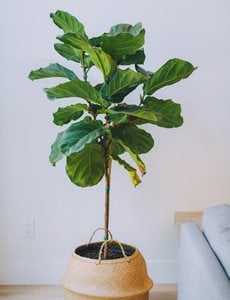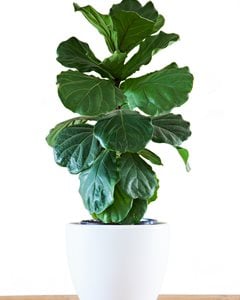How to Care for Your Fiddle-Leaf Fig
Keep your fiddle-leaf fig tree happy and healthy with a little TLC and the right growing conditions
Photo by: Shelsea Forward / Shutterstock
With huge, wavy green leaves that grow to more than a foot long, fiddle-leaf figs instantly give any room a jungle-like vibe. Lush and sculptural, this tropical plant is actually a tree capable of growing up to 50 feet tall in its jungle home. Indoors, it grows very slowly and can be kept for many years before it begins to touch the ceiling.
But even if you have the space to grow it, a fiddle-leaf fig tree can be a challenging plant to live with long-term. With a well-earned reputation for being finicky, this cold-sensitive rainforest native needs just the right conditions in order to thrive indoors. It may not be the best houseplant for apartment dwellers or the horticulturally challenged, but those willing to give it the extra attention it deserves will be well-rewarded.
On this page: Basics | Growing Tips | Care and Maintenance | Troubleshooting
On this page:
BASICS
Botanical name:
Ficus lyrata
Origin:
Western Africa
Height:
Can grow up to 10 feet tall indoors, or up to 50 feet tall if planted outdoors in a tropical climate.
Hardiness zones:
9-11
Varieties:
ln addition to the species, several interesting cultivars are available, although they can be difficult to find.
- Ficus lyrata ‘Compacta’ Little Fiddle produces leaves half the size of regular fiddle-leaf figs and grows to less than 5 feet tall.
- Ficus lyrata ‘Bambino’ is a dwarf version, growing 3 to 6 feet tall. Perfect near a large window.
- Ficus lyrata ‘Variegata’ is a showy variegated hybrid with leaves that have creamy yellow edges.
Longevity:
10 years or longer, or until the plant outgrows its space
Special attributes:
The large leaves are great indoor air purifiers and filter out harmful VOCs.
Toxicity:
Leaves are toxic if consumed. Keep out of reach of children and pets. Also avoid exposure to the sticky sap secreted from a freshly cut leaf or stem, which may cause skin irritation.
GROWING TIPS
Subscribe to the Garden Design channel on YouTube for more videos!
Location:
Choose a room that’s big and bright, like a great room, sun room, large foyer, or atrium. This indoor tree needs plenty of elbow and ceiling room to accommodate its eventual size and to show off the spectacular leaves.
Light:
Locate near an east or south-facing window with bright indirect or brightly filtered light. Avoid direct sunlight, which can burn the leaves.
Temperature:
Fiddle leaf is very sensitive to temperature fluctuations, so place it in a warm room (60° to 85° F) away from drafts and heating and air conditioning vents. Do not buy your plant in the winter (or anytime the outdoor temperature dips below 50° F), so it won’t be exposed to the cold when bringing it home.
Humidity:
The best gift you can give your fiddle-leaf is a humidifier because it prefers jungle-like, above-average moisture levels. If the air in your home is dry, mist the leaves occasionally or place a small humidifier nearby.
Soil:
Use a good all-purpose potting mix that drains well.
Watering:
From spring to fall, water when the top inch of the soil feels dry; water more sparingly during winter.
Fertilizing:
Fertilize during the active growing season (spring through fall) with a high-nitrogen foliage plant food that includes micronutrients. You can even find fertilizers specially formulated for fiddle-leaf fig trees and other ficus. Don’t feed during the winter months.
FIDDLE-LEAF FIG CARE

Photo by: Ros Fraser / Shutterstock
Leaf care:
Clean the leaves every one to two weeks with a damp cloth to rid them of dust and keep them nice and shiny. Removing dust will also let more sunlight get to the leaves and aid in photosynthesis. Also clip off any brown or damaged leaves; they can’t be revived, and your plant will look better and stay healthier without them.
Repotting:
When your fiddle-leaf is young, repot it every spring into a pot about 2 inches in diameter larger than the current one. Use a heavy container to help prevent toppling, or nest a plastic container with drainage holes inside a sturdier one made of clay or ceramic. You may also need to add a bamboo cane or moss-covered pole for support. As the plant matures and becomes too unwieldly for repotting, top dress it instead by scooping out the top 2 to 3 inches of soil and replacing it with fresh potting mix.
Pruning and shaping:
Fiddle-leaf takes well to pruning, allowing you to control its height and shape.
- For a bushier shape and less height, cut off the top of the main stem at the desired height and new growth will develop from that point.
- If you’re going for a treelike form, allow the plant to grow tall and then remove the lower leaves and branches to reveal the woody trunk.
- If your plant becomes spindly, you can make it fuller by pinching off new growth at the ends of the branches, making your cuts slightly above a leaf node.
TROUBLESHOOTING
Leaves drop:
A sudden loss of leaves is usually a sign of a stressed-out plant. “Fiddle-leaf fig doesn't like being moved around, so once you have found the right spot for it, leave it there," says Veronica Peerless, author of How Not to Kill Your Houseplant. Other causes of stress could be exposure to dry air or drafts and over or under watering. Peerless recommends giving your plant about six weeks of recovery time after a stressful move.
Yellowing leaves:
This is usually a sign of overwatering or not enough sunlight. When watering, aim to get the potting mix moist but not soggy.
Leaf tips turn brown:
Probably due to low humidity or under watering. Peerless suggests misting the leaves regularly, especially in centrally heated rooms, and taking care to water at regular intervals, making sure the entire root ball becomes well moistened.
Dark patches or spots on leaves:
Dark patches could be sunburn from exposure to direct sunlight, and small dark spots could be a sign of leaf spot disease, says Peerless. Caused by bacteria or fungi, leaf spot is more likely to occur in damp conditions or if water has been left on the leaves. The best remedy is to remove any affected leaves and treat with a fungicide.
Plant is leaning to one side:
Most likely, your fiddle-leaf is simply trying to get closer to the light source. Turn it regularly or tie the trunk to a support.
Pest control:
Fiddle-leaf figs are susceptible to number of plant pests, especially spider mites and scale insects. Inspect the leaves often, and if your plant becomes infested, gently wash the leaves with a damp cloth and treat with an organic pesticide. (See more on how to get rid of pests on houseplants)
RELATED:
The Best Philodendrons to Grow Indoors
A Guide to Growing Peace Lily
21 Best Indoor Plants


